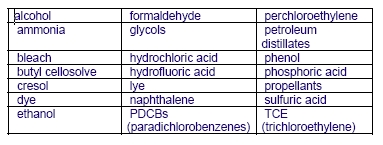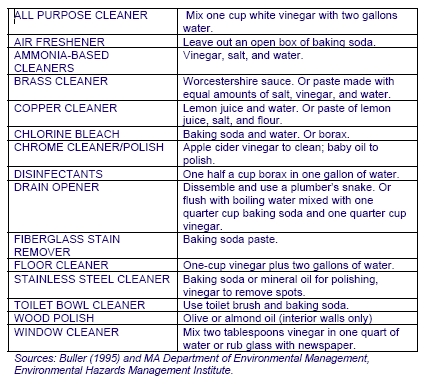New York Sea Grant's
Marina Pollution Prevention Web Site
Section 5: Facility
Management
- Facility Cleaning
Potential Environmental Impacts
Many common cleaning products contain hazardous chemicals that
with repeated or excessive contact may lead to lung problems,
brain and nerve damage, cancer and even death. Hazardous chemicals
can often be found in drain cleaners, floor-care products, window
sprays, and bathroom cleaners. Those labeled "DANGER"
or "POISON" are typically most hazardous. Others may
be labeled "CAUTION" or "WARNING" because
they are skin or eye irritants. Less hazardous alternatives for
common cleaning products are often labeled "non toxic."
Best Management
Practices
Use
cleaning products which may have less of an impact on the environment
because they are less toxic and contain lower concentrations of
volatile organic compounds (VOCs), ozone depleting chemicals (ODCs),
and/or carcinogens.
Read product
labels. Avoid cleaning products with:

Depending
on the cleaning job, always try cleaning with water and a coarse
cloth first. Clean more often with fresh water only. If you must
use a cleaner, use the product sparingly.
Consider non-toxic
alternatives for cleaning products. Even non-toxic substances
can cause temporary harm to the environment and should therefore
be used sparingly. Some non-toxic alternatives to typical cleaning
products are:

Regulatory
Issues:
There are
no legal requirements to use environmentally preferable products.
Note that waste cleaning products must be disposed of in accordance
with the hazardous waste disposal requirement. To determine if
waste cleaning products are hazardous, the generator must either
have waste materials tested or utilize reliable "knowledge
of process" information for the waste (if available) [40
CFR 262.11, click
here]. Such information could include information
from product labels, testing by haulers, or studies by industry
trade groups. For more information on New York hazardous waste
testing requirements, click
here. If hazardous, cleaning product waste must
be managed in accordance with hazardous waste storage and handling
requirements [40 CFR 262.11, click
here] For more information on New York's Hazardous
Waste Regulations and storage requirements, click
here.

